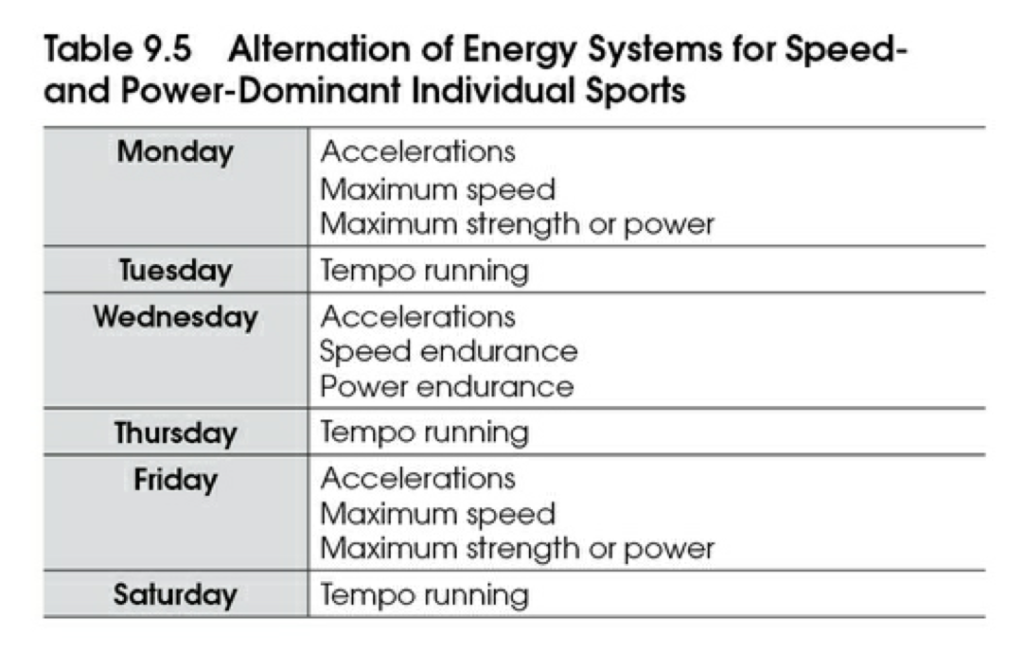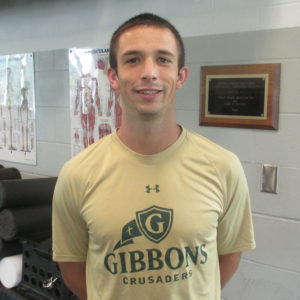
As a track athlete, a developing coach, and a person who would describe myself as a “student” of the sport, I feel that I have gathered a quality understanding of the periodization concept called the microcycle (a week).
One of the most important prefaces regarding implementing the annual plan that I have heard is to ‘write in pencil’. The microcycle is where the eraser comes out in the annual plan.
The day-to-day evaluation of preparedness, upcoming competitions, recognized strengths and weaknesses of developed attributes is crucial to microcycle design and implementation. Bompa’s chapter on this does an excellent job discussing the needs of a microcycle based on a needs analysis of an athlete. As a decathlete (10 track and field events done in 2 days) there is a need for an immense variety of training stimuli, large volumes of technical work and appropriate management of fitness and fatigue. During a specific preparation period, a period I am currently in, we will regularly hit:
- accelerative speed, top end speed,
- extensive or intensive tempo running,
- maximum strength,
- power development,
- technique in two to three different jumping events,
- hurdles within the various types of speed work,
- throwing events including two implements,
- circuit training of different varieties, hurdle mobility, and sprint development drills.
This is not an all-inclusive list; however, it covers the basics, as you can see in reading those, the overall volume of our training becomes overwhelming. I feel that programming, especially for a decathlete, is a work of art. This art is based on our understanding of training, periodization and appropriately attacking the strengths and weaknesses of athletes. Rather than diving into the deeper science of this chapter, I thought a more practical look at the microcycle would be appropriate.
In general, the first goal of a microcycle should be appropriate density(describe density) of training, appropriate progression or regression from the previous cycle depending on needs and appropriate implementation. In assuming all of these things, you can begin to look at and evaluate the true beauty of a great microcycle. Bompa explains a microcycle design for speed and power dominated athletes, a category which includes decathletes.

As you can see in Table 9.5, Mondays focus on Accelerations, Maximum speed and/or maximum strength or power. Wednesdays have a similar focus substituting maximum speed for speed endurance and max strength for power endurance. Thursdays within Bompa’s system are tempo running, as are Saturdays. Friday’s focus is the same as Monday’s. This is an extremely close representation to our daily decathlon training focuses within a given microcycle.
In general, this system is a functional one that can likely produce success with the vast majority of athletes but let me explain why it does not line up exactly with our training design:
My application of the micro cycle to the sport of decathlon:
1.
The decathlon is a game of marginal gains across 10 potentially balistic events. Gain weight? Your throws will thrive, but your speed will suffer. Run less volume at a higher intensity? Your top speed will improve but your mid-distance race my fall. Adjust your practice schedule to allow for technical focus? Your technique will improve but if this focus takes away from strength or speed within this event, your performance may fall. The event forces you to play devil’s advocate and ultimately make the decision you think is best without being certain that your choice won’t come back to bite you elsewhere. With all of this considered, the tried and true way of training decathletes seems to operate within the lines of a system we call ‘high-low’ within our training.
The system we employ involves a high central nervous system demand day, followed by a day with lower CNS demands.
2.
The high CNS day has a lower focus on aerobic development, while the ‘low’ days typically include a higher proportion of focus on development of what would typically be described as mid-distance training. We typically have 3 ‘high’ CNS days a week. One of these days will have a heavy concentric focus, it will include short sprints, an Olympic movement or regression, and strength development of some sort, typically along the maximum strength ‘range’. Another high day will have a larger focus on top end speed development. This is a higher eccentric load and our lift typically has an eccentric bias as well. Depending on the time of the year, the 3rd high CNS day could be either accelerative, maximum velocity or speed endurance focused. Bompa’s Monday, Wednesday and Friday sessions fall extremely in line with ours. There are 7 days in a week and likely 6 in a training week.
3.
My biggest application is that Bompa’s utilization of ‘tempo running’ without explanation or justification on Tuesday, Thursday and Saturday. No one is without bias. However, in evaluating a program, I have found that including tempo running 3 days a week typically has some potential negatives regarding speed development and durability in a mature athlete. Too much tempo could mean that in races of 400m or more, performance may improve, if they are still healthy. However, tempo running 3 days a week would likely have a negative impact on races that are less than 400m. Depending on your definition of speed, from a track standpoint, tempo running 3 days a week would have some downside. Our focus Tuesday, Thrursday and Saturday, aside from occasional technical components, focuses on development of the aerobic system with an additional restorative aspect. With this being said, because of the high intensity and volume of sprinting on Monday, Wednesday, and Friday, reducing the total volume of running proves to reduce the taxing components of a microcycle on the legs. Typically within our training plan, we will do 1.5 of these days on our feet with the remaining training coming in some form of circuit training with similar energy system development goals. This reduces the stress on the lower half of the body and when appropriate responses in the body occur regarding restoration, the ‘bounce back’ is more successful because the week has been appropriately managed. Management within a microcycle is also crucial.
4.
Without good management, even the best program will fail. From a microcycle perspective, I believe monitoring to be a big piece of the puzzle. There are fancy tools to do this. At Athletic Lab, we have the benefit of utilizing the fusion sport jump mat and regularly check our reactive strength index (RSI) on a weekly basis. After collecting some data from previous tests, we are able to ‘get a feel’ on where our body’s ability to perform is relative to our best performance in the recent past. When our RSI is notably lower than normal, the training volume is typically reduced, the intensity may drop, and the focus may shift. There have been times when we were due to spike up, run at maximum intensity and measure our performances to evaluate if our execution appropriately impacted our times. When our RSI is over 10% lower than high quality training days in the past, the spikes stay off, we focus on resisted runs and putting ourselves in the best position possible. The entire remainder of the week will be appropriately adjusted. The microcycle for the following week will remain similar in principle and will be adjusted to meet athlete needs based on fatigue and desires of the training load during the next microcycle.
Appropriate needs analysis, evaluation of location within the annual plan, and understanding of athlete’s current state are the initial issues to navigate before implementing an appropriate microcycle.
With great monitoring, a program that appropriately develops abilities towards the goal of the athlete over time. In addition, with good coaching/cueing, the different microcycles can develop from week to week throughout the year into a beautifully orchestrated, well implemented 6 days of training that move the athlete toward the end destination.
Successful microcycle navigation on a consistent basis will ultimately lead to an annual plan that may not look exactly as it did when it was written at the beginning of the year. However, it will be the plan that utilized day-to-day situations to progress forward without over-training and negative results!

GibbonsSTRENGTH Assistant Coach
Sport Performance Coach at Athletic Lab
USA Decathlete Sponsored by MorlandSTRENGTH
Rockin’ Refuel BOGO Holiday Special! December 16-31!
Start your New Year Resolution early by purchasing the best protein recovery that money can buy, for HALF the price.
Buy One Case, Get One FREE! $18 for TWO Cases (24 units)
Contact coach@morlandstrength.com to purchase
“The views, opinions, and judgments expressed in this message are solely those of the authors and peer reviewers. The contents have been reviewed by a team of contributors but not approved by any other outside entity including the Roman Catholic Diocese of Raleigh.”




